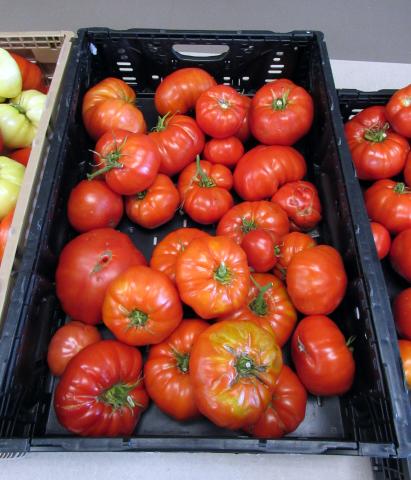URBANA, Ill. – When home gardens are bursting with an overabundance of fresh produce, growers start looking for ways to share their bounty. Backyard gardeners can help feed their community by donating fruits and vegetables to local food pantries.
Growers planning on donating to food distribution centers can take steps, even before they plant, to ensure they are providing safe, useable produce.
“Donating garden crops starts with connecting with a local food pantry,” says Staci Coussens, University of Illinois Extension SNAP-Ed educator. “Donors can find a list of pantries that will accept produce at ampleharvest.org.”
The pantry’s listing will show what produce is accepted and pantry distribution times. Contact information for the pantry manager is provided so donors can find out what the preferred drop-off time is.
The pantry manager can also advise on what produce is best to donate and what their pantry users like says Coussens. Preference varies across the state, but the most popular fresh produce items at pantries are greens, peppers, and tomatoes.
If the pantry does not have a refrigerator, only produce that is safe to store at room temperature, such as potatoes and onions, can be donated. However, donors may be able to bring produce just before distribution time so it can be handed out on that day.
Under the 1996 Bill Emerson Good Samaritan Food Donation Act, gardeners who donate fresh fruit and vegetables in good faith to nonprofit organizations for distribution to people in need from criminal and civil liability will not be held liable if someone becomes sick after eating the produce. Nick Frillman, Illinois Extension Local Foods Systems and Small Farms educator, says gardeners should follow good growing practices to reduce chances of food contamination.
“Good Agricultural Practices, or GAP, is a set of guidelines created by the USDA that help to reduce the risk of microbial contamination in fruits, vegetables, and nuts and aims to make sure these foods are safe for you or anyone that receives your food donation to eat,” Frillman says.
Gardeners planning on donating produce should pay attention to the major factors that affect food safety: Soil preparation, harvest handling and sorting, and produce washing, packing, and storage.
Most gardeners do not use manure, but this is one of the most likely ways fresh produce is contaminated. Do not use animal manure or manure-based compost at least 120 days before planting in vegetable gardens. Instead, use finished compost, available in bulk from landscaping suppliers or in bags at garden centers.
All food safety concerns are important, but especially so for crops that are typically consumed raw, like greens, tomatoes, or melons.
“We see outbreaks in particular with these types of crops in the news because they don’t require cooking to be eaten,” Coussens says.
With crops like potatoes, cabbage, winter squash and others that are rarely consumed raw, there is some added protection because the cooking required to eat these foods kills pathogenic microbes.
Growers should take extra precautions with consumed-raw crops. Trellis tomato and pepper plants so that fruits do not have contact with the soil. Wash hands when working with crops, especially on harvest day.
After harvesting crops, inspect them for things like insect damage, mold, yellow or off-color leaves, bugs, and rot.
“Creating a sorting station that is used to discard these types of things before continuing the harvest process is a must. Do not let these items make it into the harvest bin,” says Frillman.
Make sure that the containers used to deliver food donations are washed with fresh, soapy water, scrubbed out, sanitized with a light food-grade sanitizer, rinsed, and dried. Produce put in dirty bins – or even clean bins that are still wet – are subject to bacterial contamination.
Washing is necessary for some crops and not for others. In fact, washing some vegetables, such as tomatoes and peppers, can increase the risk of food safety issues. Greens should be washed with fresh municipal tap water, or a water source that is regularly tested for bacteria.
For more information on gardening, donating produce, or finding a local food pantry, connect with your local Illinois Extension county office at go.illinois.edu/ExtensionOffice.
SOURCES: Staci Coussens, SNAP-Ed Educator, University of Illinois Extension; and Nick Frillman Local Food Systems and Small Farms Educator, University of Illinois Extension
ABOUT EXTENSION: Illinois Extension leads public outreach for University of Illinois by translating research into action plans that allow Illinois families, businesses, and community leaders to solve problems, make informed decisions, and adapt to changes and opportunities.
PHOTO ACCESS: The photo in this article is available to download for media use.

